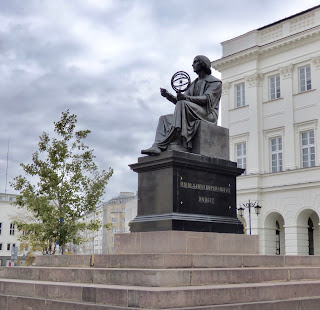October/November, 2016
Three cold and somewhat rainy days in Warsaw and, yes, I was a bit uncomfortable on my daily walks, but always in awe as I enjoyed the vibrancy of the Polish capital, a city with a tumultuous past; 85% of it razed to the ground by the German army at the end of World War II, but, according to a 2012 study, ranked one of the most livable cities in Central Europe; a testament to the strength and determination of the Polish people. Located on the Vistula River, not very far from the Baltic Sea or the Carpathian Mountains, Warsaw is the 9th most-populous city in the European Union; an international tourist destination and a cultural, political, and economic center of the country.
Historically, the city was first mentioned in 1313 when Krakow was the capital city, but due to its central location, Warsaw took the lead in 1596 with the decision of King Sigismund III Vasa to move his court. The subsequent centuries had the city under the control of Prussia, France, and Russia. Warsaw, like Krakow, gained its freedom from foreign domination in 1918 after World War I and took its place as the capital of an independent Republic of Poland.
The German invasion in 1939 subjected the city to heavy air attacks and military bombardment and began a period of death and destruction that killed millions of Poles; decimating the Jewish community that, prior to the war, had the largest Jewish population in Poland and Europe and the second largest Jewish population in the world, second only to New York. With the establishment of the Ghetto in 1940, all Jewish residents were sent to live in a designated area of 1.3 square miles that averaged 7.2 people per room and held, at its most, 400,000 Jews. Death from starvation, exposure, and infectious disease were commonplace and those brave enough to smuggle in food and medicine kept the death toll from rising even higher; even so, 83,000 deaths were recorded between 1940-1942.
An uprising in the Warsaw Ghetto in 1943 and a second Warsaw Uprising between August and October, 1944 were the catalyst of a major aerial attack by the Germans that resulted in massive damage, “flattening” the city and requiring many years of a painstaking rebuilding.
Today’s Warsaw is very much alive; universities, opera houses, theaters, libraries, and monuments abound and the historic city-center, completely rebuilt after the war, was listed as a UNESCO World Heritage Site in 1980. Walking in Old Town was a step back into the past, although I had to remind myself that the grand central square, the Royal Castle, and all those colorful, charming buildings were reconstructed between 1949 and 1963 with the goal of returning the area to its 17th and 18th century appearance.
As much as I enjoyed Warsaw, the cloud of the Holocaust continually hung over me (as it did during my entire stay in Eastern Europe). Yes, I drank Polish beer and ate plenty of perogies, but it felt bittersweet, and when I touched the remnant of the Ghetto Wall, which is located in a modern residential area and surrounded by apartments, it was a surreal, sobering moment. I fought hard to remember that good can overtake evil…if only that we never forget…
A Ravaged City After The War
Warsaw - Today
A Bit Of History And Culture
University
Presidential Palace
Old Town Charm
Sigismund's Column
Old Town Square
Barbican - Protective Gate At The Entrance To The Old City
Polish Hospitality
Love Potato Perogies!
Memorial FacingThe Museum Of The History Of Polish Jews
Nozyk Synaogoue
(only synagogue to survive the war)
The Warsaw Ghetto
Early Evening - My Last Night




























No comments:
Post a Comment